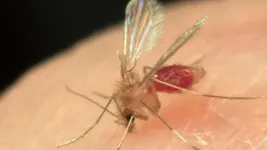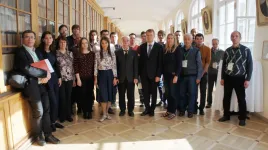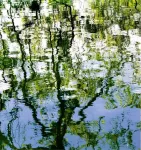(Press-News.org) Researchers at North Carolina State University and the University of North Carolina Greensboro made a surprising finding while examining areas where sand flies rear their young: a new species of bacteria that is highly attractive to pregnant, or gravid, sand flies. The findings could advance the production of ecologically safe baits or traps to reduce sand fly populations.
Sand flies are vectors for important parasitic diseases affecting people in tropical and subtropical regions in Asia, Africa and the Middle East. One of those diseases is Leishmaniasis, which generally causes sores and skin ulcers but in some cases can detrimentally affect internal organs.
"Sand flies live in sheltered places such as animal burrows, caves, and rock or tree crevices, so it's difficult to reach them with insecticides," said Loganathan Ponnusamy, principal research scholar in NC State's Department of Entomology and Plant Pathology and the corresponding author of a paper describing the research. "If you're able to attract sand flies with a chemical that attracts them in nature, you're better able to target and kill them."
The research team, which included researchers from Gideon Wasserberg's lab at the University of North Carolina Greensboro, cultured a number of different bacterial species from the sand fly larval rearing area and found one that hadn't yet been identified: Sphingobacterium phlebotomi, a new member of the family of bacteria known as Sphingobacteriaceae.
To prove that the bacterium hadn't already been identified, Madhavi Kakumanu, an NC State research scholar, performed a number of tests - including scanning electron microscopy, chemical analysis and whole genome sequencing - and showed the bacterium's novelty.
"We were culturing and isolating a lot of different bacteria and found this new one almost by accident," Kakumanu, the paper's first author, said.
Bahjat Fadi Marayati, a graduate student in Wasserberg's lab, conducted attraction tests and demonstrated that this new bacteria species produces volatile chemicals that were attractive to pregnant sand flies.
Pregnant sand flies preferred the smell of the new bacterium over other chemical compounds presented during testing, Ponnusamy said, showing that the bacterium acted as a beacon for an appropriate place for females to lay eggs.
Ponnusamy says further testing will be done to narrow down even further the chemical compounds that attract sand flies.
INFORMATION:
The paper describing the new bacterium - and presenting a name for it - appears in the International Journal of Systematic and Evolutionary Microbiology.
The paper is co-authored by NC State entomologists Ayako Wada-Katsumata, Coby Schal and Charles S. Apperson, as well as by Marayati and Wasserberg from the University of North Carolina Greensboro. Support for the work was provided by the National Institute of Allergy and Infectious Diseases under NIH grant 1R01AI123327-01 and the North Carolina Biotechnology Center under Multidisciplinary Research Grant number 1104.
Note to editors: An abstract of the paper follows.
Sphingobacterium phlebotomi sp. nov., a new member of family Sphingobacteriaceae isolated from sand fly rearing substrate
Authors: Madhavi L. Kakumanu, Ayako Wada-Katsumata, Coby Schal, Charles S. Apperson, and Loganathan Ponnusamy, North Carolina State University; Bahjat Fadi Marayati and Gideon Wasserberg, University of North Carolina Greensboro
Published: May 6 in International Journal of Systematic and Evolutionary Microbiology
DOI:10.1099/ijsem.0.004809
Abstract: A Gram-stain-negative, rod-shaped, non-motile, non-spore-forming, aerobic bacterium, designated type strain SSI9T, was isolated from sand fly (Phlebotomus papatasi Scopoli; Diptera: Psychodidae) rearing substrate and subjected to polyphasic taxonomic analysis. Strain SSI9T contained phosphatidylethanolamine as a major polar lipid, MK-7 as the predominant quinone, and C16:1 ?6c/C16:1 ?7c, iso-C15:0, iso-C17:0 3-OH and C16:0 as the major cellular fatty acids. Phylogenetic analysis based on 16S rRNA gene sequences revealed that strain SSI9T belongs to the genus Sphingobacterium, of family Sphingobacteriaceae sharing 96.5-88.0 % sequence similarity with other Sphingobacterium species. Multilocus sequence analysis using the concatenated sequences of the housekeeping genes recA, rplC and groL showed that the strain SSI9T formed a separate branch in the genus Sphingobacterium. The genome of the type strain SSI9T is 5197142 bp with a G+C content of 41.8 mol% and encodes 4395 predicted coding sequences, 49 tRNAs, and 3 complete rRNAs and 2 partial rRNAs. Strain SSI9T could be distinguished from other species of the genus Sphingobacterium with valid published names by several phenotypic, chemotaxonomic, and genomic characteristics. Based on this polyphasic taxonomic analysis, the bacterial isolate represents a novel species within the genus Sphingobacterium, for which the name Sphingobacterium phlebotomi sp. nov. is proposed. The type strain is SSI9T (=ATCC TSD-210T = LMG 31664T = NRRL B-65603T).
HOUSTON - (May 6, 2021) - A Rice University laboratory has adapted its laser-induced graphene technique to make high-resolution, micron-scale patterns of the conductive material for consumer electronics and other applications.
Laser-induced graphene (LIG), introduced in 2014 by Rice chemist James Tour, involves burning away everything that isn't carbon from polymers or other materials, leaving the carbon atoms to reconfigure themselves into films of characteristic hexagonal graphene.
The process employs a commercial laser that "writes" graphene patterns into surfaces that to date have included wood, paper and even food.
The new iteration writes fine patterns of graphene into photoresist polymers, light-sensitive materials used in photolithography and ...
As the human body's largest organ, the skin is responsible for protecting against a wide range of possible infections on all fleshy surfaces, from head to toe. So how exactly does the skin organize its defenses against such an array of threats?
A new Yale study shows that the epidermis, the outermost layer of skin, is comprised of an army of immune cells that station themselves at regular intervals across the skin's vast expanse to resist infection. When necessary, the researchers found, these immune system soldiers are able to reposition themselves to protect vulnerable areas.
The study, published in the journal Nature Cell Biology, was conducted by the lab of Valentina ...
The introduction of lithium-ion (Li-ion) batteries has revolutionized technology as a whole, leading to major advances in consumer goods across nearly all sectors. Battery-powered devices have become ubiquitous across the world. While the availability of technology is generally a good thing, the rapid growth has led directly to several key ethical and environmental issues surrounding the use of Li-ion batteries.
Current Li-ion batteries utilize significant amounts of cobalt, which in several well-documented international cases is mined using child labor in dangerous working ...
The idea of creating quantum computers has long captured the minds of researchers and experts of IT corporations. They are the most powerful computers operating according to the laws of the quantum world and capable of solving many problems more efficiently than the most productive classical supercomputers. Similar developments are underway, for example, at Google and IBM. However, many such projects require the use of cryostats. These are vessels with liquid nitrogen or compressed helium, inside which quantum processors are cooled to temperatures below -270°C. Such a low temperature is required to maintain the superconductivity effect, which is necessary for the operation ...
Today's 10,000 species of birds live in virtually every habitat on Earth, but only a handful have adaptations enabling them to hunt active prey in the dark of night. Scientists have long wondered whether theropod dinosaurs - the group that gave rise to modern birds - had similar sensory adaptations.
A new study led by University of the Witwatersrand scientist, Professor Jonah Choiniere, sought to investigate how vision and hearing abilities of dinosaurs and birds compared. The international team of researchers used CT scanning and detailed measurements to collect information ...
New Haven, Conn. -- If paleontologists had a wish list, it would almost certainly include insights into two particular phenomena: how dinosaurs interacted with each other and how they began to fly.
The problem is, using fossils to deduce such behavior is a tricky business. But a new, Yale-led study offers a promising entry point -- the inner ear of an ancient reptile.
According to the study, the shape of the inner ear offers reliable signs as to whether an animal soared gracefully through the air, flew only fitfully, walked on the ground, or sometimes went swimming. In some cases, the inner ear even indicates whether ...
The findings, published in the journal Science today, demonstrate how integrating vertical descent and horizontal gene transfer can be used to infer the root of the bacterial tree and the nature of the last bacterial common ancestor.
Bacteria comprise a very diverse domain of single-celled organisms that can be found almost everywhere on Earth. All Bacteria are related and derive from a common ancestral Bacterial cell. Until now, the shape of the bacterial tree of life and the placement of its root has been contested, but is necessary to shed light on the early evolution of life on our ...
The uncertainty principle, first introduced by Werner Heisenberg in the late 1920's, is a fundamental concept of quantum mechanics. In the quantum world, particles like the electrons that power all electrical product can also behave like waves. As a result, particles cannot have a well-defined position and momentum simultaneously. For instance, measuring the momentum of a particle leads to a disturbance of position, and therefore the position cannot be precisely defined.
In recent research, published in Science, a team led by Prof. Mika Sillanpää at Aalto University in Finland has shown that there is a way to get around ...
In the 150 years since Charles Darwin speculated that humans originated in Africa, the number of species in the human family tree has exploded, but so has the level of dispute concerning early human evolution. Fossil apes are often at the center of the debate, with some scientists dismissing their importance to the origins of the human lineage (the "hominins"), and others conferring them starring evolutionary roles. A new review out on May 7 in the journal Science looks at the major discoveries in hominin origins since Darwin's works and argues that fossil apes can inform us about essential aspects of ape and human evolution, including the nature ...
PROVIDENCE, R.I. [Brown University] -- A research team from Brown University has made a major step toward improving the long-term reliability of perovskite solar cells, an emerging clean energy technology. In a study to be published on Friday, May 7 in the journal Science, the team demonstrates a "molecular glue" that keeps a key interface inside cells from degrading. The treatment dramatically increases cells' stability and reliability over time, while also improving the efficiency with which they convert sunlight into electricity.
"There have been great strides ...








